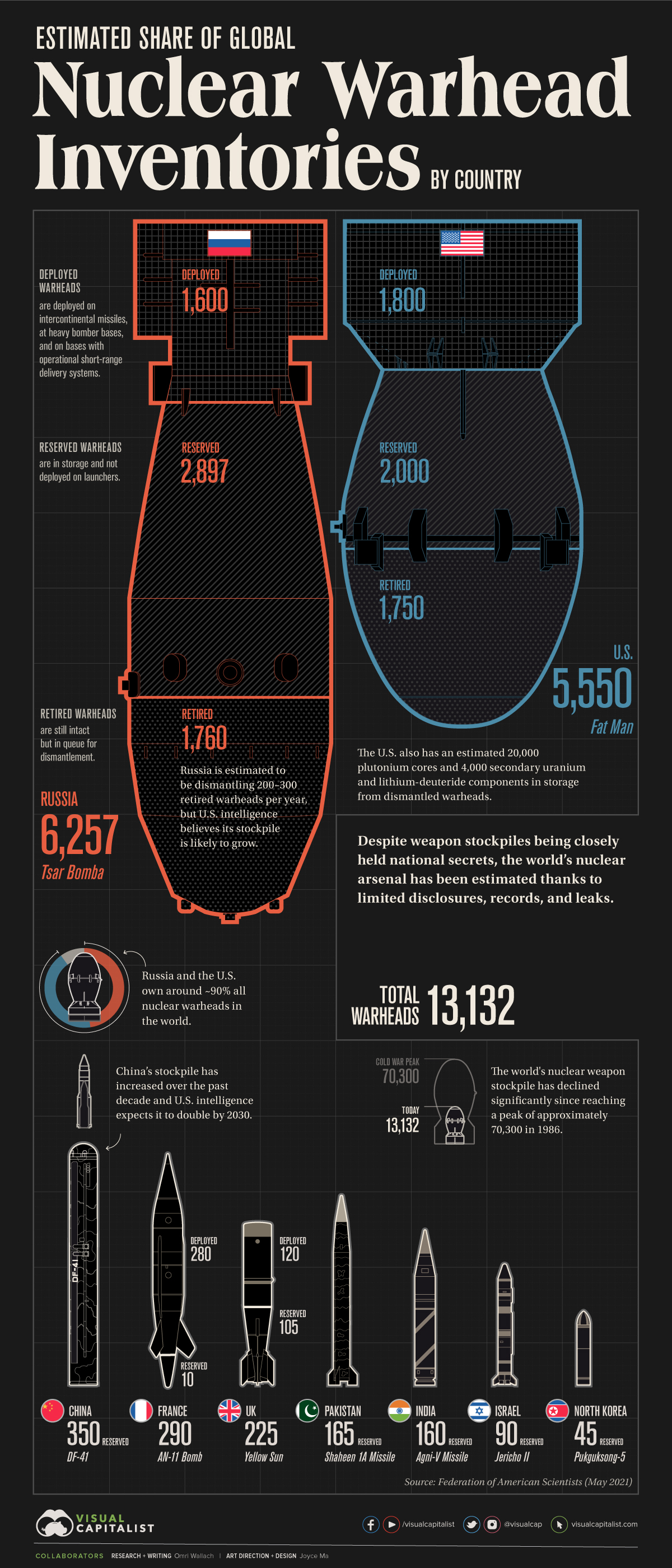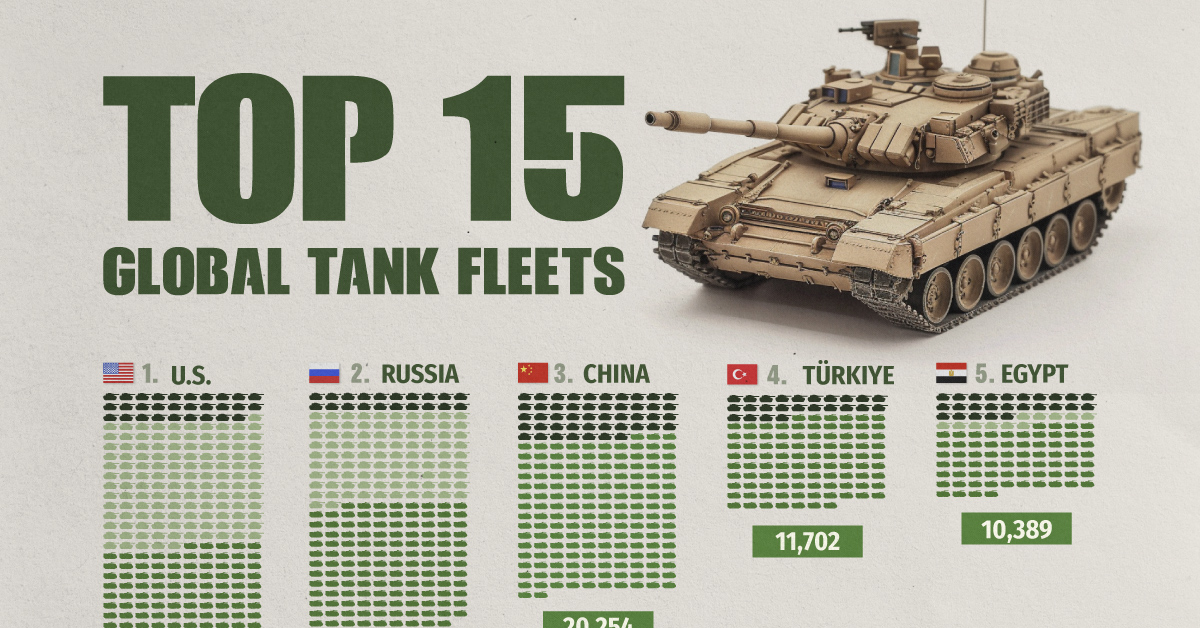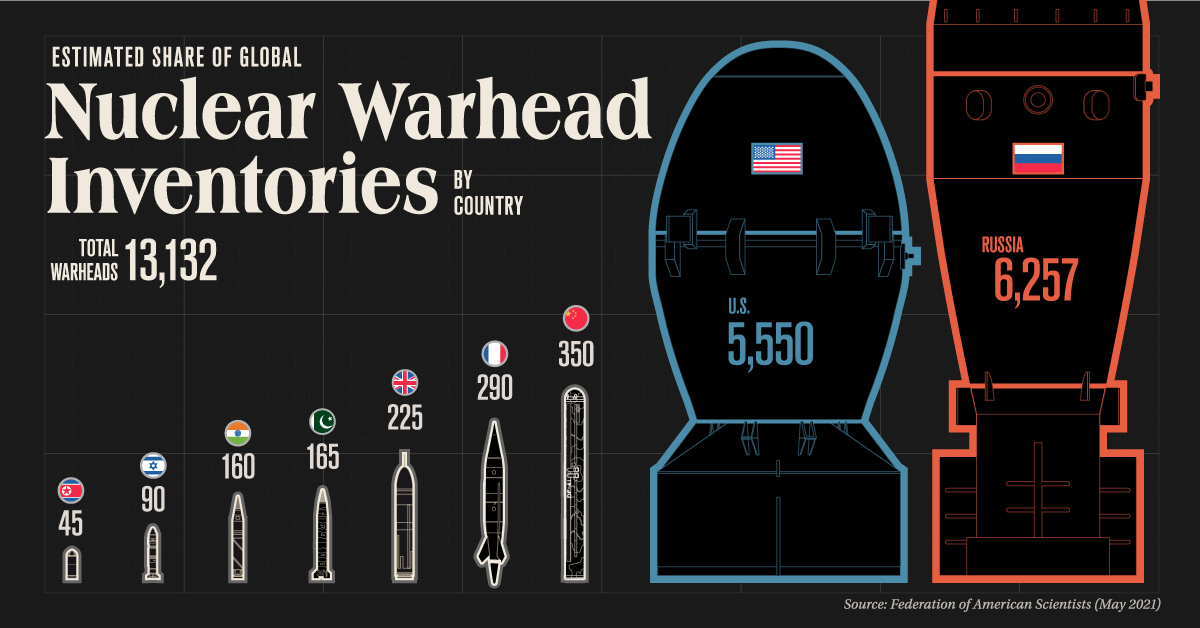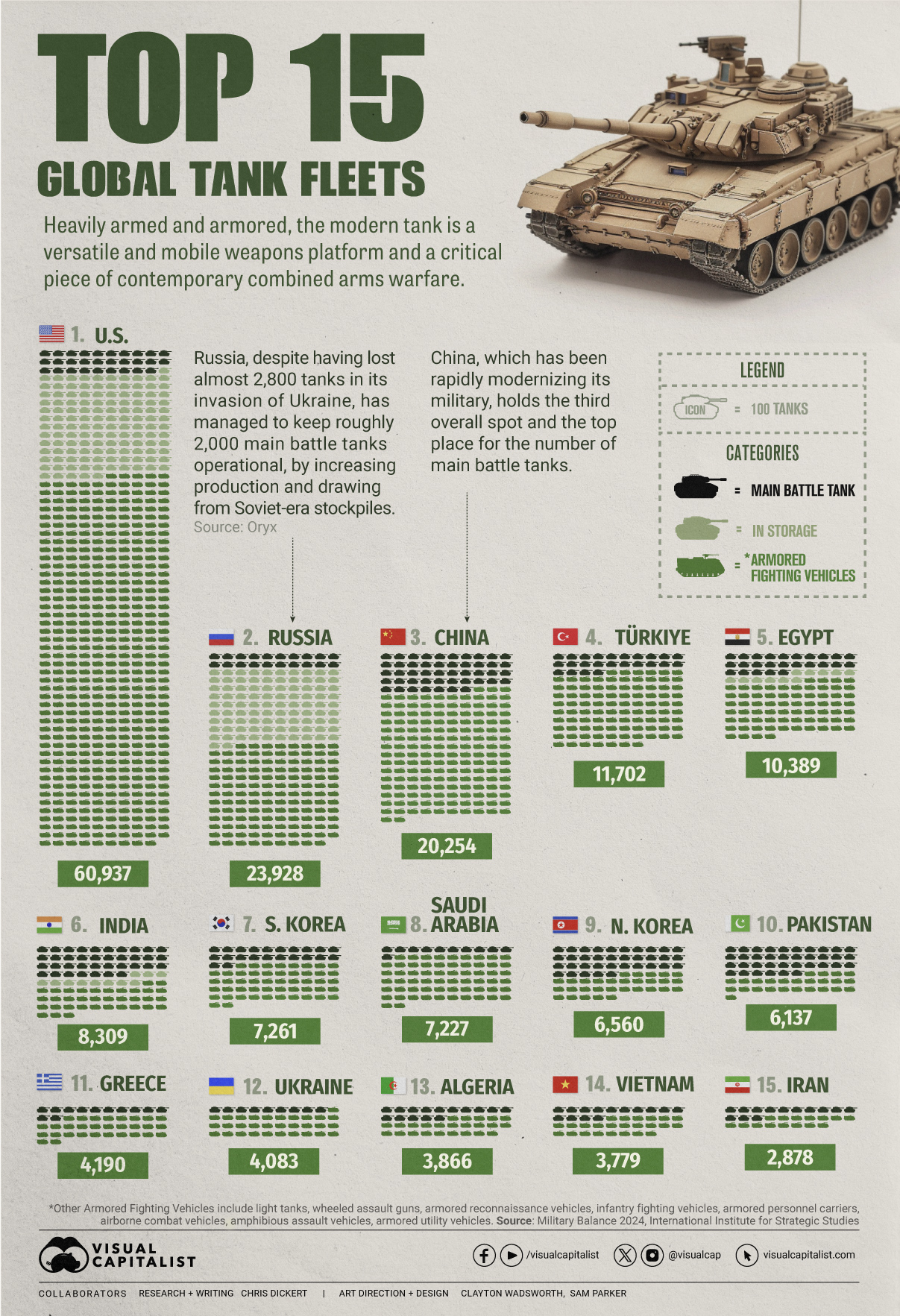War
Which Countries Have the Most Nuclear Weapons?

Which Countries Have the Most Nuclear Weapons?
In theory, nuclear weapon stockpiles are closely held national secrets. The leading countries have rough estimates that aren’t regularly updated, newly nuclear countries keep their capabilities vague and unclear, and Israel has never officially confirmed a nuclear weapons program.
But thanks to limited disclosures, records, and leaks, we can visualize the full extent* of the world’s nuclear arsenal. This graphic uses estimated nuclear warhead inventories from the Federation of American Scientists as of August 2021.
Based on these estimates, there are just nine countries with nuclear weapons in the world.
Editor’s note: Exact numbers of nuclear warheads possessed by countries are closely guarded state secrets, with the FAS estimate being the closest, most-used, and most-trusted international approximation available.
Nuclear Weapons, by Country
The nuclear arms race has always centered around the U.S. and Russia.
After the end of World War II and well into the Cold War, the world’s two superpowers raced to build more nuclear weapons (and more capable nuclear weapons) than the other.
Even while international organizations lobbied for the end of nuclear proliferation, the world’s nuclear weapon stockpile grew to a peak of 70,300 total warheads in 1986.
As arms agreements and non-proliferation treaties started to gain greater momentum, the U.S. and Russia cut back on stockpiles while new countries with nuclear weapons started to pop up.
| Country | Total Warheads (2021) | % of Total |
|---|---|---|
| 🇷🇺 Russia | 6,257 | 47.7% |
| 🇺🇸 U.S. | 5,550 | 42.3% |
| 🇨🇳 China | 350 | 2.67% |
| 🇫🇷 France | 290 | 2.21% |
| 🇬🇧 UK | 225 | 1.71% |
| 🇵🇰 Pakistan | 165 | 1.26% |
| 🇮🇳 India | 160 | 1.22% |
| 🇮🇱 Israel | 90 | 0.69% |
| 🇰🇵 North Korea | 45 | 0.34% |
Despite reducing their stockpiles significantly since the end of the Cold War, Russia and the U.S. still own around 90% of all nuclear warheads in the world.
Far behind them are China and France, which started testing nuclear weapons in 1964 and 1960 respectively. The UK has the fifth-most nuclear weapons today, though it was the third country in the world to develop them after the U.S. and Russia in 1952.
The countries with fewer than 200 nuclear weapons are regional rivals India and Pakistan, which first tested nuclear weapons in the 1970s, and North Korea, which began to operate uranium fabrication plants and conduct explosive tests in the 1980s.
Israel is also estimated to have fewer than 200 nuclear weapons, and reports have its weapons program dating back to the 1960s. However, the country has never confirmed or announced its nuclear capabilities.
Countries With Nuclear Weapons, by Warhead Status
Though the world has 13,132 nuclear weapons, that doesn’t mean they’re all ready to fire.
Weapons (or “warheads”) are delivered by missile, and countries don’t keep all of their nuclear warheads primed for use. The estimation of nuclear stockpiles also clarifies whether warheads are considered deployed, reserved, or retired:
- Deployed warheads are deployed on intercontinental missiles, at heavy bomber bases, and on bases with operational short-range delivery systems.
- Reserve warheads are in storage and not deployed on launchers.
- Retired warheads are still intact but in queue for dismantlement.
| Country | Deployed Warheads | Reserve Warheads | Retired Warheads |
|---|---|---|---|
| 🇷🇺 Russia | 1,600 | 2,897 | 1,760 |
| 🇺🇸 U.S. | 1,800 | 2,000 | 1,750 |
| 🇨🇳 China | 0 | 350 | 0 |
| 🇫🇷 France | 280 | 10 | 0 |
| 🇬🇧 UK | 120 | 105 | 0 |
| 🇵🇰 Pakistan | 0 | 165 | 0 |
| 🇮🇳 India | 0 | 160 | 0 |
| 🇮🇱 Israel | 0 | 90 | 0 |
| 🇰🇵 North Korea | 0 | 45 | 0 |
Only four countries have officially deployed warheads, while the majority of the world’s nuclear stockpile is in reserve. This is partially due to estimates ranging from relatively transparent in the case of the U.S. to opaque and uncertain for countries like China and North Korea.
But some countries are expected to further bolster their stockpiles. The UK government announced it would increase its stockpile to no more than 260 warheads, and U.S. intelligence expects China, India, and Pakistan to increase their stockpiles.
Though the world’s nuclear stockpile will likely continue dwindling on account of U.S. and Russia retirements, the 2021 landscape of countries with nuclear weapons shows that proliferation is still underway.
War
Visualized: Top 15 Global Tank Fleets
Heavily armed and armored, the modern tank is a versatile and mobile weapons platform, and a critical piece of contemporary warfare.

The Top 15 Global Tank Fleets
This was originally posted on our Voronoi app. Download the app for free on iOS or Android and discover incredible data-driven charts from a variety of trusted sources.
Heavily armed and armored, the modern tank is a versatile and mobile weapons platform, and a critical piece of contemporary warfare.
This visualization shows the top 15 global tank fleets, using data from the 2024 Military Balance report from the International Institute for Strategic Studies (IISS).
Let’s take an in-depth look at the top three fleets:
1. United States
As the world’s pre-eminent military power, it’s perhaps no surprise that the United States also has the largest tank fleet, by a wide margin.
In total, they have just over 45,000 armored fighting vehicles in operation, along with 2,640 main battle tanks (MBTs), and 12,800 vehicles in storage, of which 2,000 are main battle tanks.
| Category | Vehicles | Global rank |
|---|---|---|
| Main battle tanks | 2,640 | 4 |
| Armored reconnaissance | 1,745 | 1 |
| Infantry fighting vehicles | 3,262 | 3 |
| Armored personnel carriers | 10,644 | 1 |
| Amphibious assault vehicles | 1,401 | 1 |
| Armored utility vehicles | 28,445 | 1 |
| Storage | 12,800 | 1 |
| Total | 60,937 | 1 |
The U.S. is internalizing the lessons from the ongoing invasion of Ukraine, where Western-supplied anti-tank weapons and massed Ukrainian artillery have been cutting Russian tanks to pieces. As a result, the U.S. recently canceled an upgrade of the M1 Abrams in favor of a more ambitious upgrade.
Meanwhile, the U.S. is nervously eyeing a more confident China and a potential clash over Taiwan, where air and naval forces will be critical. However, a recent war game showed that Taiwanese mechanized ground forces, kitted out with American-made tanks and armored fighting vehicles, were critical in keeping the island autonomous.
2. Russia
According to Oryx, a Dutch open-source intelligence defense website, at time of writing, Russia has lost almost 2,800 main battle tanks since invading Ukraine. Considering that in the 2022 edition of the Military Balance, Russia was estimated to have 2,927 MBTs in operation, those are some hefty losses.
Russia has been able to maintain about 2,000 MBTs in the field, in part, by increasing domestic production. Many defense plants have been taken over by state-owned Rostec and now operate around the clock. Russia is also now spending a full third of their budget on defense, equivalent to about 7.5% of GDP.
At the same time, they’ve also been drawing down their Soviet-era stockpiles, which are modernized before being sent to the front. Just how long they can keep this up is an open question; their stockpiles are large, but not limitless. Here is what their storage levels look like:
| Category | 2023 | 2024 | YOY change |
|---|---|---|---|
| Main battle tanks | 5,000 | 4,000 | -20.0% |
| Armored reconnaissance | 1,000 | 100 | -90.0% |
| Infantry fighting vehicles | 4,000 | 2,800 | -30.0% |
| Armored personnel carriers | 6,000 | 2,300 | -61.7% |
| Total | 16,000 | 9,200 | -42.5% |
3. China
China holds the third overall spot and top place globally for the number of main battle tanks in operation. Untypically, the People’s Liberation Army has no armored vehicles in storage, which perhaps isn’t surprising when you consider that China has been rapidly modernizing its military and that stockpiles usually contain older models.
China also has one of the world’s largest fleets of armored fighting vehicles, second only to the United States. Breaking down that headline number, we can also see that they have the largest number of light tanks, wheeled guns, and infantry fighting vehicles.
| Category | Vehicles | Global rank |
|---|---|---|
| Main battle tanks | 4,700 | 1 |
| Light tanks | 1,330 | 1 |
| Wheeled guns | 1,250 | 1 |
| Infantry fighting vehicles | 8,200 | 1 |
| Armored personnel carriers | 3,604 | 5 |
| Airborne combat vehicles | 180 | 2 |
| Amphibious assault vehicles | 990 | 2 |
| Total | 20,254 | 3 |
This is equipment that would be integral if China were to make an attempt to reunify Taiwan with the mainland by force, where lightly armored mechanized units need to move with speed to occupy the island before Western allies can enter the fray. It’s worth noting that China also has one of the world’s largest fleets of amphibious assault vehicles.
End of the Tank?
Many commentators at the outset of Russia’s invasion of Ukraine, were quick to predict the end of the tank, however, to paraphrase Mark Twain, reports of the tank’s demise are greatly exaggerated.
With the U.S. and China both developing remote and autonomous armored vehicles, tanks could be quite different in the future, but there is nothing else that matches them for firepower, mobility, and survivability on the modern battlefield today.
-

 Education1 week ago
Education1 week agoHow Hard Is It to Get Into an Ivy League School?
-

 Technology2 weeks ago
Technology2 weeks agoRanked: Semiconductor Companies by Industry Revenue Share
-

 Markets2 weeks ago
Markets2 weeks agoRanked: The World’s Top Flight Routes, by Revenue
-

 Demographics2 weeks ago
Demographics2 weeks agoPopulation Projections: The World’s 6 Largest Countries in 2075
-

 Markets2 weeks ago
Markets2 weeks agoThe Top 10 States by Real GDP Growth in 2023
-

 Demographics2 weeks ago
Demographics2 weeks agoThe Smallest Gender Wage Gaps in OECD Countries
-

 Economy2 weeks ago
Economy2 weeks agoWhere U.S. Inflation Hit the Hardest in March 2024
-

 Green2 weeks ago
Green2 weeks agoTop Countries By Forest Growth Since 2001

















